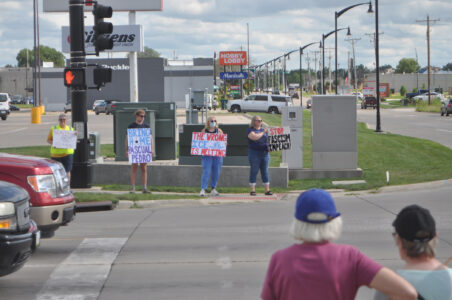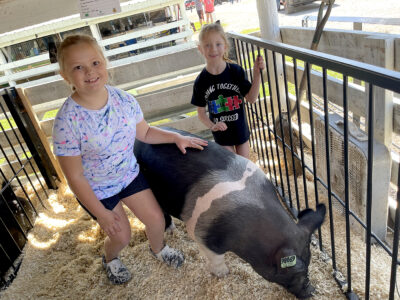‘Shots began to fly’
Witness testifies about shooting
-
-Messenger photo by Kelby Wingert
Defense attorney Christopher Kragnes questions witness Jeremiha Hatten while defendant Michael Shivers listens on Friday morning.
-
-Messenger photo by Kelby Wingert
Dr. Dennis Klein, Iowa State Medical Examiner, testifies during Michael Shivers’ murder trial at the Webster County Courthouse on Friday morning.
-
-Messenger photo by Kelby Wingert
First Assistant Webster County Attorney Ryan Baldridge gestures on a sketch of the crime scene from the June 16, 2020, shooting, during testimony from firearms expert Michael Tate on Friday morning.

-Messenger photo by Kelby Wingert
Defense attorney Christopher Kragnes questions witness Jeremiha Hatten while defendant Michael Shivers listens on Friday morning.
Testimony in Michael J. Shivers’ murder trial continued on Friday with the Webster County jury hearing from the state medical examiner, investigators who interviewed the defendant, a DNA expert, and another witness to the shooting.
Shivers, 56, of Eagle Grove, is standing trial for two counts of second-degree murder and one count of possession of a firearm as a prohibited person in connection with a June 2020 shootout in the Pleasant Valley neighborhood that led to the deaths of two men.
Jamael Cox, 25, and Tyrone Cunningham, 47, both of Fort Dodge, died from their injuries sustained in a volley of bullets in the 900 block of 10th Avenue Southwest around 4:45 a.m. on June 16, 2020.
The jury heard from a witness from the shooting who had previously been charged with two counts of second-degree murder.
Jeremiha Hatten, of Fort Dodge, was charged along with Michael Shivers and three other men on Nov. 10, 2020. The state later dismissed those charges in July. Hatten was then charged with one count of intimidation with a dangerous weapon, a Class D felony that carries a sentence of up to five years in prison..

-Messenger photo by Kelby Wingert
Dr. Dennis Klein, Iowa State Medical Examiner, testifies during Michael Shivers' murder trial at the Webster County Courthouse on Friday morning.
Several people were gathered at the home of DarTonya Shivers, a brother of the defendant, the night prior and the morning of the shooting to celebrate the life of a recently-passed family member.
Hatten was at the celebration of life because he’s in a relationship with Cierra Shivers, a niece of the defendant. He described the atmosphere at the start of the gathering.
“There was still some sadness, but the comfort was there,” he said.
People started showing up, both to the Shivers residence, and to the park across the street, Hatten testified.
“Everything was fine at first,” he said.

-Messenger photo by Kelby Wingert
First Assistant Webster County Attorney Ryan Baldridge gestures on a sketch of the crime scene from the June 16, 2020, shooting, during testimony from firearms expert Michael Tate on Friday morning.
Isiah Mosley came up to a group of people that Hatten was with, Hatten testified. He said Mosley just talked with people there, describing Mosley as “calm” and “cool.”
He said Mosley was not acting aggressively in any way and stayed for about 10 or 15 minutes.
“At a certain point, did the mood change?,” First Assistant Webster County Attorney Ryan Baldridge asked.
“It went from happy parlaying, you know, everyone having a good time, to complete separation and quiet,” Hatten said.
Hatten testified that at the time of the shooting, Michael Shivers was in possession of a Bushmaster AR-15 rifle and that he had been the one to fire the first bullet.
“What happened after he fired his AR-15?” Baldridge asked.
“Shots began to fly,” Hatten said.
He said shots were coming from “both sides,” and that he couldn’t tell how many people were shooting.
Hatten also admitted to having a Kimber .380 handgun that night and to firing it once the bullets began to fly. He said he fired his weapon three times.
When the dust settled and it was clear that police would be arriving imminently, Hatten said, another guest at the party, Darrell Jones, told the individuals who had been firing weapons to urinate on their hands “to help remove powder residue.”
Baldridge asked Hatten why he wasn’t completely truthful with law enforcement during his first interviews with investigators.
“I simply didn’t want my in-laws to feel like I was a traitor,” Hatten said..
During his cross-examination, defense attorney Christopher Kragnes implied that Hatten was lying on the stand in order to secure a favorable plea deal with the state, asking him questions like “Is the ceiling red?” and “Is my desk blue,” both to which Hatten replied they weren’t.
“I’m just curious as to why I can’t get you to say ‘yes’ to something that is untrue, and the state can,” Kragnes said.
“I’m just here to tell the truth from my perspective,” Hatten said.
“What’s your belief of what happens to you and your plea agreement if it’s determined you are not truthful?” Kragnes asked later.
“I go to prison,” Hatten responded.
Iowa State Medical Examiner Dr. Dennis Klein testified on his findings during the autopsies of Cox and Cunningham.
Klein testified that the cause of death for Cox was a gunshot wound to the chest. While conducting his autopsy, Klein found a bullet entrance wound on the side of Cox’s left arm. Klein showed the jury autopsy photographs that showed how the bullet passed through the muscle in the arm and into the left side of the chest before exiting through the front of the chest. He said the bullet passed through a lung, the heart and also affected part of the stomach and large intestine.
The autopsy on Cunningham showed that he died from a “fatal level of blood loss” due to a gunshot wound on his left leg between the knee and ankle, the medical examiner testified.
“As the bullet passed through and struck bone, the bone fragmented and caused a lot of damage as those fragments exited the leg,” Klein said.
Assistant Iowa Attorney General Doug Hammerand asked if this kind of damage is consistent with a high-powered rifle.
“Yes. There’s a lot of energy in a bullet, and that energy is absorbed by the tissues of the body,” Klein said.
For both men, Klein testified that the manner of death was ruled homicide.
Kragnes asked if Klein was able to determine who shot any of the projectiles recovered from the victim’s bodies, or if he was able to determine the order in which the projectiles were fired. Klein answered that he was not.
Former Fort Dodge Police Detective Larry Hedlund, who is now an investigator with the Webster County Attorney’s Office, testified that during an interview on June 19, 2020, Michael Shivers denied having a gun at any time during the incident.
“He said with 100% certainty that he never had a gun, or ammunition or touched a gun that night,” Hedlund testified.
He said the defendant described the shooting as a “simultaneous eruption of shots” and wasn’t able to say which side started it.
At one point, several witnesses have testified, Mosley showed up and there appeared to be some tension between Mosley and the individuals at the Shivers residence.
While talking with Hedlund days later, Michael Shivers made several comments like “Maybe both sides got tired of waiting to see who was going to back down first,” Hedlund testified.
Hedlund also testified that Michael Shivers never claimed he had been acting in self-defense and that even after Hedlund told him others had said that he had a gun that night, he continued to deny having a gun.
Kragnes asked Hedlund about the tensions between the Shivers family and Mosely. Hedlund said Michael Shivers told him that he had learned Mosley was in the area and looking for Devontae Naylor-Foy.
“They had some beef, and they wanted him to come to the park,” Hedlund said.
Across from DarTonya Shivers’ residence is the H.C. Meriwhether Park
Kragnes asked if Hedlund considers Mosley “very dangerous.” Hedlund said he did.
Special Agent Chris Calloway, who was with the Iowa Division of Criminal Investigation during the investigation, testified that he interviewed the defendant on June 22, 2020, and that the defendant had claimed that “Dinkey,” a nickname for James Davis Jr., may have fired the first shot.
Michael Shivers also admitted to Calloway that he had shot a 38-caliber revolver the night of the shooting, Calloway testified. He said Shivers told him it was a “raggedy-ass five- or six-shot revolver with tape on the handle” and “not a very functional weapon.” The firearm has never been located.
“Did the defendant say where he was shooting at?” Hammerand asked.
“Toward some people that were down the street,” Calloway answered, later adding that the defendant specifically identified Mosley.
“He said he hoped he’d hit him, that he was a bad seed,” Calloway said.
Calloway also testified that during the first interview on June 22 or the second interview on July 1 with Michael Shivers, the defendant never said he had feared for his life or others that night or that he had acted in self-defense. Michael Shivers also denied shooting the Bushmaster AR-15 rifle, but admitted to holding it at some point during the night.
Scott Stocksleger, a DNA expert from the DCI crime lab, testified that he found three blood stains on the Bushmaster AR-15 rifle and was able to create a DNA profile from the samples. Most of the DNA, he said, matched Marissa Anderson, who was another victim in the shooting, who survived her injuries.
Stocksleger said the samples also held “minor contributing DNA,” but there was not enough DNA to determine a match with any known samples.
Firearms expert and criminalist from the state crime lab Michael Tate testified to processing several spent shell casings collected from the scene, including five found in the bed of a pickup truck, that he was able to positively identify as coming from the Bushmaster AR-15 rifle also collected at the scene.
On cross-examination, Kragnes asked which of the casings Tate was able to determine was the one that was fired first in the incident.
“I have no idea,” Tate answered.
The trial will continue on Monday morning. Follow Kelby Wingert on Twitter at @KelbyWingert for live updates.







